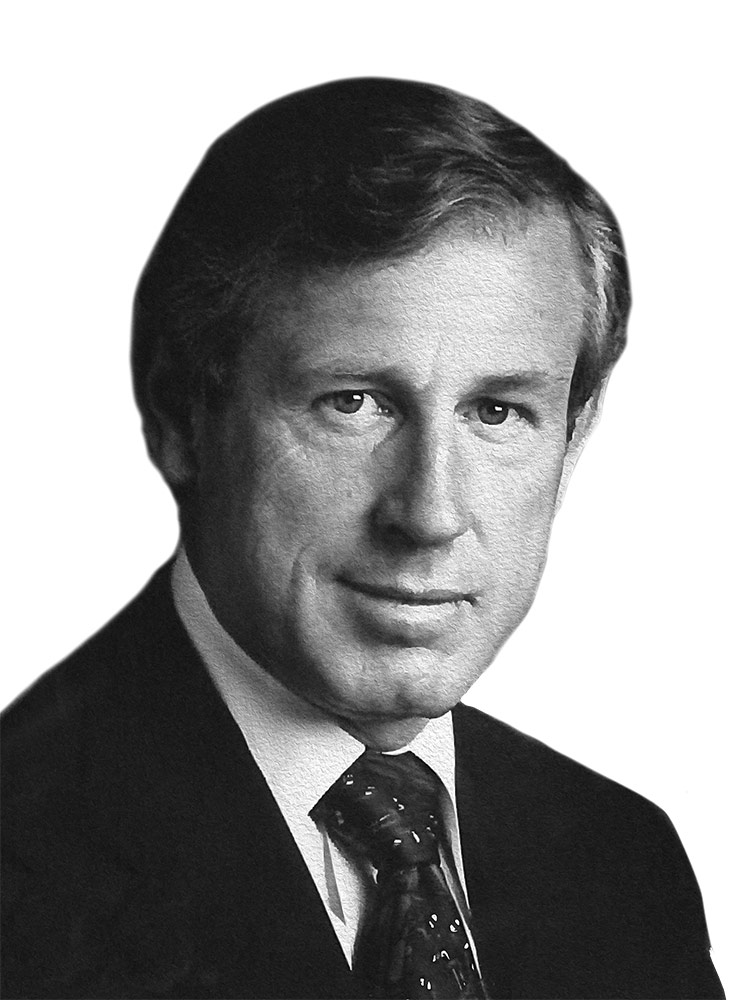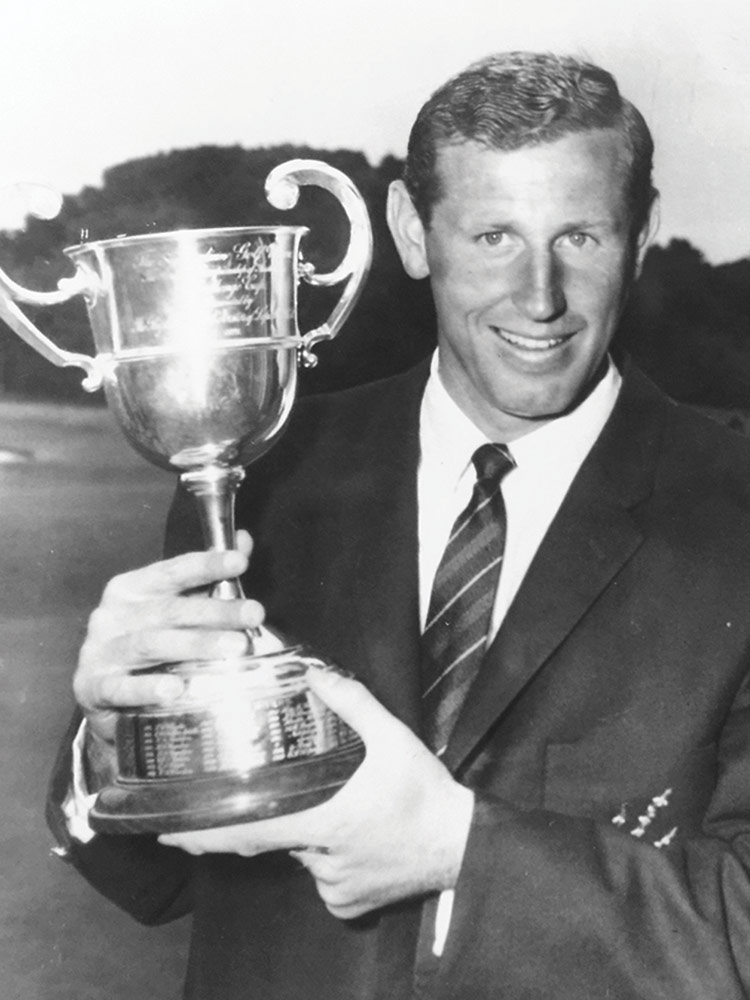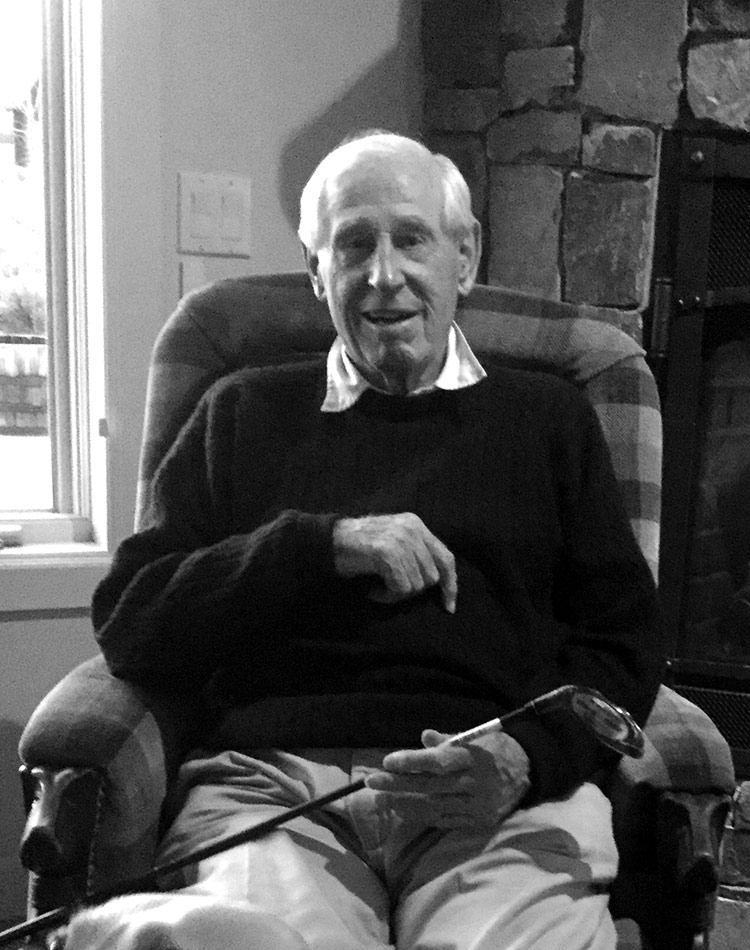Tom Crow was a unique talent who founded Cobra Golf and transformed it into an equipment behemoth that endures as one of the most recognisable brands in golf.
It’s about half a century since Tom Crow enjoyed a moment of inspiration while admiring the ‘big cats’ on Sydney Harbour. Watching the majesty of a catamaran skipping across the waves got Crow thinking. The double-hulled sailing boats possessed lower resistance to pass through water as well as great stability.
Their efficiency intrigued Crow as to whether his favoured sport of golf could benefit from their design characteristics. Crow always wanted a club that didn’t ‘dig’ into the ground – something that would get the ball airborne quickly.
Some years later after founding Cobra Golf, Crow developed the ‘Baffler’, a troubleshooting club with the loft of a 5-wood that featured thick railed-brass soleplates. With about 5 degrees of ‘bounce’, the leading edge skipped across the turf rather than digging into it – much like the hulls of the catamarans on Sydney Harbour.
The Baffler revolutionised golf in the late-1970s, firstly at the professional level and then by making the game easier for less-accomplished amateurs. Its commercial success validated Crow’s move to California where he founded Cobra.
That Crow was able to build Cobra Golf into a company worth three-quarters of a billion dollars is one of the greatest success stories in the history of Australian golf.

An Incredible Journey
Sadly, the beautiful mind that conceived the Baffler [below] is no longer with us. While he’s still in good shape physically, his cognitive abilities have declined gradually over the past four years.
Today, the 85-year-old is increasingly dependent upon his wife Cally and son Jamie at their home in Jackson Hole, Wyoming, a town famous for mountain men and freezing temperatures. It’s not uncommon to see a herd of bison or gang of elk in the snow-ridden fields outside the Crow residence, which is a far cry from Tom’s childhood in Melbourne.
Born on August 23, 1931, Thomas Leslie Crow was the youngest of three brothers who grew up in the inner eastern suburb of Camberwell. Tom began playing golf as a lefty, but switched to right-handed in his early teens at the urging of older brother Peter who had read about the scarcity of good left-handed clubs.
Tom was a natural athlete and charismatic leader, as evidenced from his time at prestigious Scotch College Melbourne where he was elected school captain in 1950. He represented the school in AFL, swimming and cricket. As a left-arm fast bowler, he took 134 wickets at an average of 10.45. (Shortly afterwards, Crow walked into Collingwood’s first-grade side and represented the Victoria Second XI
in 1952.)
But golf was his true calling. Crow won more than 20 club championships at Kingston Heath, Royal Melbourne and Royal Sydney. He won the 1952 Victorian Close Championship, 1956 Victorian Amateur Championship and 1957 Victorian Champion of Champions (shooting a course-record 63 on Royal Melbourne West).
Crow twice captured the Riversdale Cup (1961, 1962) and represented Australia at the Eisenhower Trophy teams’ event on two occasions (1962, 1964). His crowning achievement, however, was victory in the 1961 Australian Amateur when he defeated Phil Billings in the final.
Upon leaving school, Crow worked in life insurance. But that didn’t interest him and he entered the golf industry through a job offer from Clare Higson to manage the Victorian office of clubmaker East Brothers. That was back in the days when Australia was a world leader in golf club manufacturing.
After two years, Crow moved to Sydney to become international marketing manager for East Brothers, which merged with Chesterfield to become Precision Golf Forging (PGF). The role would take Crow to the West Coast of America, the Far East of Asia and beyond.
During his time at PGF in the 1960s, Crow had input into what many considered the world’s first utility club. PGF’s ‘Little Slammer’ featured a smaller clubhead (made from a thermoplastic resin called Cycolac), a rounded heavy brass sole and a slightly shorter shaft than other woods. The Little Slammer was very popular in Australia.
Former colleague John Higson recalls: “Tom had a lot of ability in club design and was very well read. And he developed a lot of his knowledge from Ernest Kermeth, who was the general manager of PGF.”

How Tom Crow Conquered America
However by 1973, Crow was disillusioned about the impending sale of PGF to the international conglomerate Colgate-Palmolive. He had made relatively little from the success of the Little Slammer. So at the age of 42, he decided to pack up his young family and relocate to California with the unshakable belief he could produce his own clubs and pitch them to the American market. Kerry Packer was one of Crow’s original backers and supported him to the tune of about $10,000.
Incidentally, the origin of the name Cobra is an interesting side story. The Crows were sitting in the living room of their Bellevue Hill home in Sydney’s eastern suburbs. Tom was adamant he needed a one-word name to capture the imagination. Some of the big equipment makers at the time were defined by one iconic word: MacGregor. Ping. Ram. Wilson. Cally Crow, a more than competent artist, started doodling on a piece of paper. She drew an image of a snake that caught Tom’s attention: “Perfect! Cobra strikes back. Good for marketing.”
Elsewhere in 1973, the American clubmaker Stan Thompson created the ‘Ginty’, a laminated-head ‘trouble’ club with the loft of a 7-wood. It was specifically designed to provide distance and forgiveness in every swing from the fairway, sand or rough.
In 1975, Crow released the Cobra Baffler, a utility wood featuring a patented soleplate design that helped golfers get the ball out of fluffy rough, hardpan and buried lies. But the real challenge was to market the product.
Crow would make unannounced visits to golf courses from San Diego to Florida where he would meet the head professional, show him the Baffler and get the pro to hit a few shots. He was always inquisitive for feedback and wanted to know what they thought. In most instances, Crow would convince the pro to take at least a couple of clubs for sale in the shop.
Despite Crow’s determination, Cobra Golf was twice on the verge of bankruptcy. Third time lucky, he met Gary Biszantz, a Ford franchisee who sold his car dealership to come on board and manage the business.

The Baffler gained traction in the late-1970s when big names such as Gene Littler employed it in tournament play to deal with heavy rough. At one particular US Open it seemed like there were a hundred competitors with a Baffler in the bag. And as the pros gave it their stamp of approval, the masses began to follow.
“Of course, the amateurs loved it because they could hit it fat and the ball will just go straight up in the air and it will go forever,” says Jamie Crow (who was a member of Australia’s successful Eisenhower Trophy campaign in 1996).
The Baffler was the making of Cobra Golf and the first of many innovative designs. In 1979, Cobra introduced a 46-inch extended-length driver onto the market. The ‘Long Tom’ featured both a lightweight graphite head and shaft, which was three inches longer than standard. The substitution of graphite for steel was a revolutionary step that Crow gleaned from Asia where its use was more widespread in manufacturing.
In 1985, Cobra was the first American club manufacturer to offer stock graphite-shafted woods and irons. The Lady Cobra and Senior range of woods and irons featured game-improvement graphite technology. In 1989, Cobra introduced the revolutionary autoclave system that allowed graphite shafts to be strengthened through a compression-curing process to guarantee high performance.
Joining the team in the mid-1980s was Mark McClure, a former ski instructor and golf pro, who turned out to be a marketing whiz. All of a sudden, Cobra had a dynamic trio in charge with Biszantz handling the finances, McClure the sales and marketing while Crow provided the creative nous behind club production.

Cobra’s great growth spurt occurred after the signing of Greg Norman and Hale Irwin to endorsement deals in 1991. Norman had met Crow previously and the two Australians had formed a good rapport.
But rather than simply pay Norman a lump-sum fee, he was offered an equity stake in the company, the opportunity to assist with club development and to own the Cobra distribution system in Australia. Norman acquired a 12 per cent stake in Cobra Golf worth $1.9 million.
In 1992, Cobra launched its first full set of oversized irons in response to Callaway Golf’s Big Bertha clubs. In order to help launch its King Cobra line of oversized clubs, Cobra Golf was publicly listed in 1993, raising $US38.5 million from an initial public offering of 3.25 million shares.
Incidentally, Crow offered every PGA pro who was a Cobra stockist the right to buy 200 shares (under the family and friends scheme). Many bought in and almost doubled their money instantly. To this day, PGA pros in America thank Crow for giving them the opportunity to make some extra money on the side if they were willing to take the gamble.
In 1994, King Cobra men’s clubs were a phenomenal success, becoming the No.1 selling irons. Cobra became synonymous with oversize irons and the company launched popular King Cobra clubs for seniors and women.
“Professionals don’t buy golf clubs. And [Dad] wanted to make golf clubs that the average guy could play with and get better at,” says Jamie Crow. “So that’s why he invented the oversized irons. And remember, the Prince tennis racquet had just come out, which was the first oversized tennis racquet.
“He wanted something that was going to be easier for the average guy to be able to hit. And that’s where he made his niche market – for seniors and the ladies … He designed clubs for swing speed, not for gender.”
By 1996, Cobra Golf was a leader in the oversize iron market as well as graphite-shafted irons for players with slower swing speeds. At the time, Cobra had annual turnover approaching $US300 million and approximately 1,200 employees at its Carlsbad factories in San Diego County.
That same year American Brands (Acushnet’s parent company) purchased Cobra Golf for $US754 million. It’s been speculated Norman made more than $US50 million from the sale.
But Cobra struggled as part of the Acushnet stable. Titleist-branded clubs began offering the same game-improvement features that appealed to a wider range of golfers, thereby putting them in competition with Cobra rather than complementing the brand.
Still, the innovations continued, including newer versions of the Baffler. In 1998, short-game guru Phil Rogers designed the Trusty Rusty wedges made of soft, unplated carbon steel with a tri-bounce sole design and a distinctive ‘scallop’ in the back of the flange for greater versatility and feel.
Crow retired more than a decade-and-a-half ago. But his legacy lives on. In 2003, the PGA of America acknowledged Crow’s achievements by bestowing him with the Ernie Sabayrac Award for life contribution to the golf industry.
Jamie adds: “[Dad] always thought outside the box. And he was willing to listen to people. He wasn’t so set on his own ideas. He would listen to somebody talk about something and then he’d take it from there to a different place.”
In 2010, Cobra Golf was sold to Puma AG and the merged entity became a major player in the golf industry as an equipment and footwear manufacturer. Cobra Puma Golf has grown as a lifestyle brand through athletic young players such as Rickie Fowler and Lexi Thompson.
Today, Cobra Puma Golf is one of the most recognisable brands in golf.

Did You Know…
The Baffler name was a word play on the baffy and baffing-spoon, the most lofted club in a set of spoons, which was used primarily for approach shots in the late-19th century.
▶ ▶ ▶
For several years in the 1950s, Tom Crow would travel to England as Peter Thomson’s “manager”. In 1958, Crow arranged a sponsorship deal for Thomson that was worth more than the £1,000 he received for winning his fourth British Open title at Royal Lytham & St Annes.
▶ ▶ ▶
During his time at PGF, Tom Crow became very good friends with Lee Kuan Yew, the first Prime Minister of Singapore. On one occasion they were playing golf at Singapore Island Country Club. With the threat of assassination after Singapore’s separation from Malaysia in 1965, they had a platoon of soldiers lining the fairway, a platoon behind them and a platoon waiting ahead on the next hole.
▶ ▶ ▶
In 1999, Tom Crow played a pivotal role in Adam Scott’s development. Phil Scott credits Crow for introducing Adam to Butch Harmon when the teaching guru was highly sought after due to his association with Tiger Woods. Harmon fine-tuned a swing that would eventually capture Australia’s first Masters title and the world No.1 ranking.



